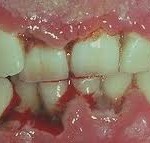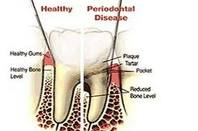A periodontal abscess is a localized area of inflammation in which there is formation of pus has take place in our periodontal tissues. Periodontal tissues consist of gingiva, cementum, alveolar bone, and the periodontal ligament.
A periodontal abscess is a localized area of inflammation in which there is formation of pus has take place in our periodontal tissues. Periodontal tissues consist of gingiva, cementum, alveolar bone, and the periodontal ligament.
Gum disease is an infection in the gum tissues and bone that keep your teeth in place. There are two types of gum disease, gingivitis and periodontitis.
Deep gum cleaning consists of scaling and root planing. Gum disease (gingivitis) if untreated can progress to more
serious periodontal disease (bacterial/viral proliferation which overwhelms the host immune response) causing destruction of the supporting tissues of the teeth and bone loss which are irreversible in nature. A periodontal pocket forms and harbors bacteria in large amounts. Deep scaling and root planning are the therapeutic procedures performed to heal your gums by removing the disease causing toxins. Scaling is the process of removing dental tartar from the teeth surfaces while root planning involves removing infected tooth structure (dentin and cementum) and smoothing the rough root surfaces of the teeth. The goal of active therapy is to remove as much subgingival debris as possible and disrupt/ the bacterial proliferation. Continue reading
Trench mouth is also known as Acute Necrotizing Ulcerative Gingivitis (ANUG) or Vincent’s infection. It is an acute

ANUG
 necrotizing inflammatory disease produced by endogenous infection where systemic changes, predispose the gingiva to invasion by bacteria. A recurring periodontal disease which results in necrosis and ulceration of the gums. It is a communicable infection of the respiratory tract and mouth extending to the tongue, palate, throat and pharynx. ANUG is a mixed bacterial infection with predominant groups of anaerobic bacteria, the fusiform, spirochetes and treponema. They present in large numbers in slough and necrotic tissue at surface of the ulcer and invade a small distance into underlying connective tissue, releasing toxins and enzymes. Trench mouth is a serious oral disease which causes severe pain and major discomfort. Inability to carry out good oral hygiene and poor nutritional status are the contributing factors of trench mouth. Other causes include smoking, increased physical and emotional stress, age, poverty and infections like HIV, AIDS and measles, malignant tumors and acute leukemia.
There are many types of gum diseases, with the most common one being gingivitis, which is the inflammation of the gums. Everybody will have gingivitis to some extent, however, some individuals with very bad oral hygiene will have severe gingivitis. (Sometimes, gingivitis occur even with a good oral hygiene as there are many causes of gingivitis) To relieve the symptoms of gingivitis, some herbal remedies can be used. However, to completely remove the underlying cause of the inflammation, a trip to the dentist has to be taken. Only then, will the symptoms not recur. Continue reading
Â

Gingival recession is a dental condition characterized by shrinking gums which expose root surfaces and reduces the zone of attached gingiva. It is a precursor for loss of thin cementum surrounding the teeth and wearing of enamel at the gum line. Exposed root is potentially sensitive via exposed dentinal tubules which can transmit stimuli to the pain receptors in the pulp (inner nerve). Cold, hot and sweet stimuli, drying with an air spray and the use of an ultrasonic scaler results in sensitivity. This situation deters the patient from brushing properly leading to plaque accumulation on the root surface and aggravates the sensitivity. It develops during late teens and early 40’s. Continue reading
Pyria of the gums means bleeding of the gums, which does not occur in healthy gums. Bleeding of the gums can happen spontaneously, or after slight provokation, like after brushing the teeth. This usually occurs when there is inflammation of the gums, as the blood vessels beneath the gums will dilate and can rupture more easily. This is a serious indication that there is something wrong with your teeth, and should be seen by the dentist as soon as possible. Continue reading
What is gingivitis?
Gingivitis is the inflammation of the gum tissue. It  most commonly occurs in response to bacterial biofilms on the tooth surface, also called plaque. Therefore this form of gingivitis is termed ‘plaque induced gingivitis’. Gingivitis can also occur due to other causes such as hormonal change (eg.pregnancy), systemic diseases (eg. diabetes) and blood dyscrasias. If gingivitis is not treated at the early stage, it may progress to periodontitis, a destructive form of periodontal disease which is characterised by bone loss, pocketing and gum recession. Continue reading
Orthodontic treatment is common in both children and adults. They type of treatment and appliance advocated may vary from patient to patient, but majority of them treated wear fixed appliances for a certain period of time. Therefore, it is necessary to make some diet modifications to protect the braces as well as to ensure the health of the tissues in the mouth. It is wise to avoid or eliminate a list of beverages for this very reason. Continue reading

Bone loss
For our convenience, the term bone loss is differentiated to two types in our mouth. The loss of bone specifically involving jaw (alveolar) bone area but are not involving teeth is referred as dental bone loss. Meanwhile, teeth bone loss means loss of roots of teeth or the jaw bone surrounding teeth. At times, it is possible to have both bone loss happening simultaneously. Continue reading